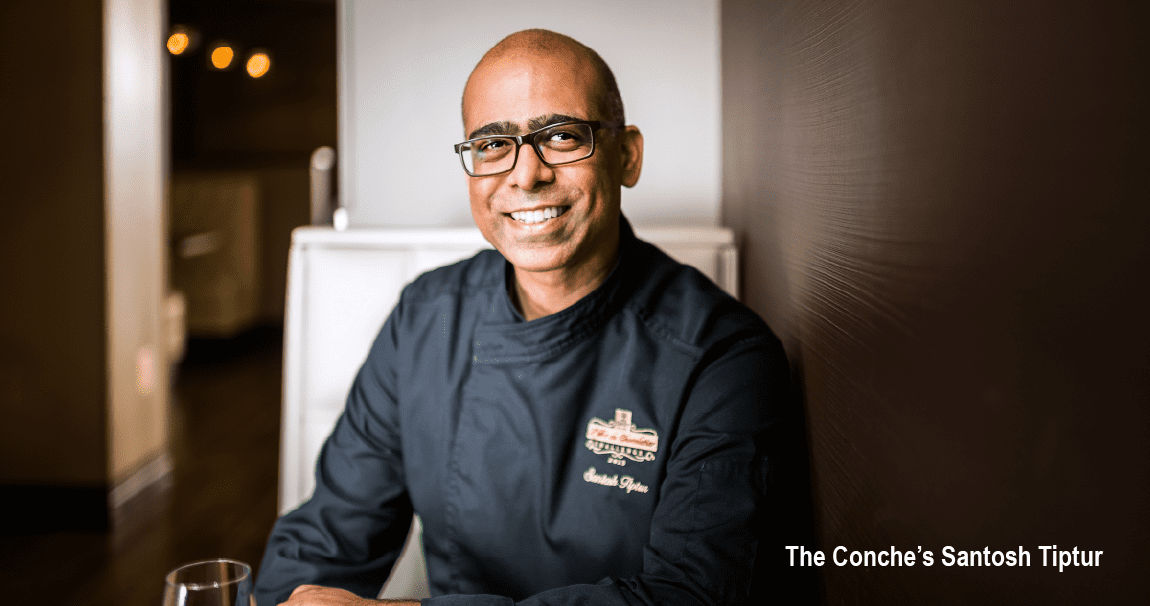Celebrity chefs captivate the masses with their culinary creations, whether on-screen, in publications, or simply through word of mouth. These household names, in theory, carry weight to a restaurant and generate additional business to developments and projects by those who want to experience the renowned dishes of a famed chef. Washington, D.C. and its suburbs, in recent years, have become a hub for celebrated restauranteurs to open and expand their businesses. The question is: how much weight do celebrity chefs and chef-driven concepts actually carry for the real estate accommodating their dining concepts?
Santosh Tiptur, a Loudoun County local and Food Network “Halloween Wars” winner, opened the 2,864-square-foot chocolate-inspired boutique restaurant The Conche at the Village at Leesburg shopping center in Northern Virginia in 2017 after nearly a decade as Co Co. Sala’s Executive Chef in downtown D.C.. The restaurant garnered high marks and drives customers from greater distances willing to taste the dishes of a famous foodie. Since opening, The Conche increased its revenue by nearly 60% between August 2017 and 2018 and takes in some of the top sales per square foot among retailers at the Village of Leesburg. While this could be due to a variety of factors, people are looking at these figures and giving credence to the belief that a noteworthy name indicates success. “Both Village at Leesburg and the public benefit from the success of The Conche,” said Susan Bourgeois, Rappaport’s Senior Director of Leasing and Brokerage who handles Village at Leesburg’s retail leasing. She continues, “Since opening, several of Chef Tiptur’s industry colleagues are considering joining the center or doing just that, including Michael Pearce, who owns the Wine House in Fairfax and is opening Vino Bistro this month.”
Mixed-use development and shopping center landlords and owners notice this and seek to capitalize on the trend themselves. Bisnow reported in August that landlords are granting better deals to prominent chefs, despite the astronomical restaurant tenant improvement rates within the D.C. market. “Landlords are more likely to offer chef-driven concepts additional concessions due to the uniqueness they bring to a project. Typically, they receive more free rent, more tenant improvements, and a lower base rent. They may even be offered 30-40% higher tenant improvements than their operation-driven counterparts because, oftentimes, a landlord believes they are going to make it up in a percentage rent,” says Mike Howard, Rappaport’s Executive Director of Brokerage who has previously worked with notable chefs such as Michelin-starred Fabio Trabocchi, Nobu Matsuhisa, and José Andrés.
More sizeable square-footages and elaborate build-outs are also on the menu if a chef-driven concept opportunity appears. Masseria’s Nick Stefanelli received 12,000 square feet for a Greek restaurant at Midtown Center as well as nearly 14,000 square feet to create Officina at The Wharf in Southwest D.C., housing a café, Italian market, three kitchens, a restaurant, and a rooftop bar expected to open next month according to Washington Business Journal. Similar provisions have been struck in other regions as well, with a colossal 35,000 square feet given to José Andrés’ Mercado Little Spain in downtown Manhattan, slated to open in 2019.
While signs suggest celebrity chefs and chef-driven concepts are sought after to ensure the strength of real estate projects, Mike views this scope as too limited. “There are great creative restaurant operators out there that are not chef-driven receiving the same benefits as a celebrity chef. Ultimately, it’s about having the right project, the right location, and the right concept to bring a unique experience from which the landlord benefits.”



